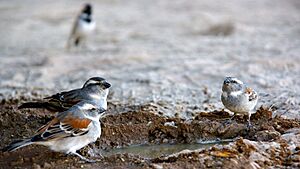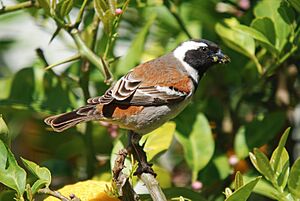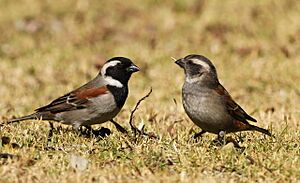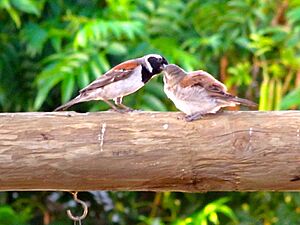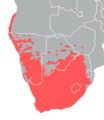Cape sparrow facts for kids
The Cape sparrow (Passer melanurus), also known as the mossie, is a type of bird found in southern Africa. It belongs to the sparrow family, Passeridae. This medium-sized sparrow is about 14 to 16 centimeters (5.5 to 6.3 inches) long. It has special markings, including light stripes on its head that both males and females have.
Its feathers are mostly grey, brown, and chestnut. Male Cape sparrows have bold black and white marks on their heads and necks. These birds live in dry grasslands, farmed areas, and towns. Their home range stretches from the central coast of Angola to eastern South Africa and Eswatini. There are three slightly different types (subspecies) of Cape sparrows found in different parts of this area.
Cape sparrows mainly eat seeds, but they also munch on soft plant parts and insects. They usually breed in groups called colonies. When they are not breeding, they gather in large groups that move around to find food. They can build their nests in trees, bushes, holes, or even in old nests made by other birds. A typical nest holds three or four eggs. Both parents help with breeding, from building the nest to feeding the young birds.
The Cape sparrow is common in most places where it lives. It gets along well in cities with two related birds: the native southern grey-headed sparrow and the house sparrow, which was brought to Africa from other places. The number of Cape sparrows is not dropping much, and human activities don't seriously threaten them. Because of this, the International Union for Conservation of Nature (IUCN) lists them as a species of least concern, meaning they are not at risk of disappearing.
Quick facts for kids Cape sparrow |
|
|---|---|
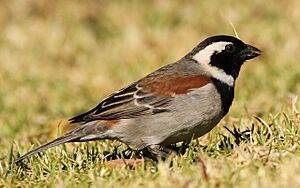 |
|
| Male in Roodepoort, South Africa | |
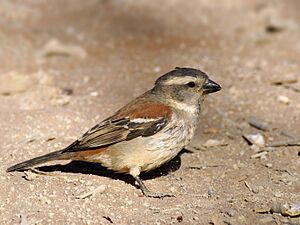 |
|
| Female in Sossusvlei, Namibia | |
| Conservation status | |
| Scientific classification | |
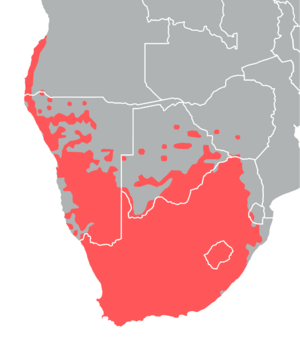 |
|
| Range | |
| Synonyms | |
|
Contents
What They Look Like

The Cape sparrow has striking colors and is easy to spot for a sparrow. It's a medium-sized bird, about 14 to 16 centimeters (5.5 to 6.3 inches) long. Adult birds weigh between 17 and 38 grams (0.6 to 1.3 ounces).
Male Sparrows
Breeding males have mostly black heads. They have a wide white stripe on each side that curls from behind the eye down to the throat. A thin black band connects the black chest patch to the black on the head. Their undersides are greyish, getting darker on the sides. The back of the male's neck is dark grey, and its back and shoulders are a bright chestnut color. Males also have white and black stripes on their wings below their shoulders. Their flight feathers and tail have grey and black streaks.
Female and Young Sparrows
Females look similar to males but are duller in color. Their heads are grey and have a different pattern than the males, though you can still see a hint of the pale head markings. Young sparrows look like females, but young males start to get black marks on their heads early on.
Their Calls
The Cape sparrow's calls are chirps, much like those of the house sparrow. However, they sound more musical and gentle. Their basic call is used when flying or resting with others. It sounds like chissip, chirrup, or chirrichup. Males use a loud, clear call to show they own a nest. This call can sound like tweeng or twileeng. This call can also turn into a jerky, repeated song, like chip cheerup, chip cheerup.
Where They Come From
The Cape sparrow was first described by a scientist named Philipp Ludwig Statius Müller in 1776. It is part of the Passer group, which includes the house sparrow and other sparrows from the Old World.
Scientists have studied the Cape sparrow's DNA. They believe it is one of the oldest types of sparrows in its group. It likely separated from other sparrows more than 5 million years ago. It is most closely related to the southern grey-headed sparrow and other grey-headed sparrows in Africa. It's also related to the saxaul sparrow found in Central Asia.
The scientific name for the Cape sparrow, melanurus, comes from two Greek words. Melas means "black," and oura means "tail." The name of the group, Passer, is a Latin word for small birds.
There are three slightly different types of Cape sparrows:
- Passer melanurus melanurus lives in western South Africa.
- Passer melanurus vicinus is found from Free State to Eastern Cape and Lesotho.
- Passer melanurus damarensis lives in southern Angola, Namibia, Botswana, southern Zimbabwe, and northern South Africa.
Where They Live
The Cape sparrow lives in southern Africa, south of Angola and as far east as Eswatini. You can find them in most of South Africa, Namibia (except for the driest parts of the Namib Desert), and southern Botswana. They also live in a few places in southeastern Zimbabwe.
Originally, these birds lived in dry grasslands, thorny bushes, and light forests. About a thousand years ago, when farming started in their area, they learned to live in cultivated lands. Since people started building towns, they have also moved into urban areas. Cape sparrows prefer places that get less than 75 centimeters (30 inches) of rain each year. In desert areas, they usually stay near rivers or watering holes. Even though they live in cities, they prefer parks, gardens, and open spaces. They don't have as many babies in very built-up areas.
In towns, Cape sparrows share space with the native southern grey-headed sparrow and the house sparrow, which was brought to southern Africa in the 1800s. The Cape sparrow is more used to living near humans than the other two. It usually competes well with them, though the other sparrows might stop it from nesting in holes. A study in 2000 found that Cape sparrows were increasing in some parts of South African cities (like northern Johannesburg and Pietermaritzburg). However, they were decreasing in other areas (like southern Cape Town). House sparrows were also reported to be decreasing in some cities, possibly because of more garden plants or more predators.
How They Behave
Social Life

Cape sparrows are social birds. They live in flocks and usually breed in groups called colonies. When they are not living in settled areas, they spend much of the year moving around in groups of up to 200 birds, looking for food. In farmed and built-up areas, smaller groups form where food is available, like near livestock or bird feeders. In these places, they hang out with other birds that eat seeds, such as the house sparrow and the Cape weaver. Birds from cities sometimes form large groups in certain seasons. They fly out to the nearby countryside to eat ripening grain and then return to the city at night to sleep.
Cape sparrows like to sleep in nests. When they are moving around outside the breeding season, birds in wild areas sleep together in old nests or thick bushes. In farms and towns, Cape sparrows build special nests just for sleeping. These nests are not as well-made as breeding nests, but they have more soft material inside to keep them warm.
What They Eat
The Cape sparrow mostly eats seeds. They look for food in trees and on the ground. They prefer larger seeds from grains, wild grasses, and other small plants. Wheat and khakiweed are some of their favorites. They also eat buds and soft fruits, which can sometimes damage farms. They eat insects too, and it seems that baby sparrows are fed only caterpillars. Cape sparrows also eat soft plant shoots and sip nectar from aloe plants, but these are not their main food sources.
Breeding and Raising Young
Courtship and Colonies
Cape sparrows usually breed in loose colonies of 50 to 100 birds. About 10 to 20 percent of breeding pairs nest away from these colonies, but scientists don't know why. Cape sparrows are usually monogamous, meaning one male and one female pair up. However, there have been a few cases where one male and two females nested together and raised young in the same nest.
It seems that pairs form within the non-breeding flocks. We don't know exactly how pairs form or if they stay together for life. Once they are ready to breed, new pairs look for a good nesting spot. They spend mornings searching and return to their flock in the afternoon. When a spot is chosen, both birds start building their nest. Other pairs looking for a nest site join them, and that's how a colony quickly forms.
The male's courtship display (how he tries to attract a female) is not well-known. One scientist saw a male hop next to a female in a tree, dropping his wings and fluffing up the chestnut feathers on his back. Groups of two or more males have also been seen chasing a female. When a female is ready to mate, she crouches down, and the male mounts her. Sometimes, Cape sparrows have bred with house sparrows, southern grey-headed sparrows, or even escaped Sudan golden sparrows.
Nesting
Cape sparrows use many different places to build their nests. They seem to prefer bushes and trees, especially acacias. Many nests can be built in a single tree. They choose holes and other covered spots less often. Nests have been found under the eaves of buildings, on climbing plants on walls, in holes in earth banks, and in haystacks. Sometimes, Cape sparrows use the old nests of other birds, like weavers and swallows. Pairs that nest away from colonies usually choose low bushes or utility poles. Nests are placed at least a meter (3 feet) above the ground. In colonies, nests can be only a few centimeters apart.
Only the nest and the area very close to it are defended as a territory. Males protect their territory by making threatening poses and sometimes by fighting with their beaks on the ground.
Nests built in the open are large, messy, dome-shaped structures. They are made of dry grass, twigs, and other plant materials. Any leaves or thorns in the tree might be woven into the nest. If they nest in a hole, the hole is filled with a shapeless mass of grass. Inside, there's a cup of soft material for the eggs. When they use old weaver nests, they add a soft lining. The nest entrance is on the side and sometimes has a short tunnel. Both the male and female build the nest together. They stay close when finding materials and weaving them. The inside of Cape sparrow nests often has a lot of fragrant leaves, like wolbossie, thyme, and camphor. Using these strong-smelling plants might help protect the nest from parasites.
Eggs and Young
A clutch of eggs usually has between two and six eggs, but most often three or four. The number of eggs depends on how much food is available for the young birds. Clutches are larger during the busiest breeding time and in the more southern parts of the Cape sparrow's range, probably because there is more food.
Both parents take turns sitting on the eggs during the day, switching every ten or fifteen minutes. At night, only the female sits on the eggs, while the male sleeps outside or in the nest. In pairs that breed away from colonies, the bird sitting on the eggs leaves the nest when it hears its partner coming. In colonies, the bird waits until its partner arrives in the nest to stop other birds from entering. Incubation seems to start before all the eggs are laid and lasts for 12 to 24 days.
The young birds hatch over two or three days. They are kept warm until their feathers grow and their eyes open, about five days after hatching. The young are fed insects until they are ready to fly, which is usually 17 days after hatching (but can be 16 to 25 days). After they leave the nest, they are fed for another one or two weeks. While feeding the babies, the female is in charge over the male. Cape sparrows are often hosts for the dideric cuckoo, which lays its eggs in their nests. Sometimes, Cape sparrows also lay their eggs in other Cape sparrow nests.
How They Interact with Humans
The Cape sparrow is a very common bird that lives near people and farms in most of southern Africa. It is not considered to be in danger. Because of this, it is listed as a species of least concern on the IUCN's IUCN Red List. However, it can sometimes be a pest for farmers, especially in grain fields and vineyards.
Around 1956, when vineyards in the south-west Cape started letting weeds grow between the grapevines to save water, the Cape sparrows moved in. The sparrows quickly ate all the weed seeds and then started eating the grapes. Now, the Cape sparrow is a serious problem in vineyards. Vineyards are not the best place for them to live, and some groups of sparrows there have so few babies that they would not survive without new birds coming in from other areas.
The Cape sparrow was shown on the lowest-value South African coin, from the farthing (¼-cent) in 1923 to the cent that stopped being made in 2002. The designs were based on an original by George Kruger Gray. This was said to be because women held in a concentration camp during the Boer War adopted a Bible quote as their motto: "Are not two sparrows sold for a farthing? and one of them shall not fall on the ground without your Father." The Cape sparrow has also been featured on stamps from Lesotho and the Central African Republic.
Images for kids
-
A male in Western Cape, seen from the front
-
Cape sparrows and a southern masked weaver at a bird feeder in Johannesburg during the winter



